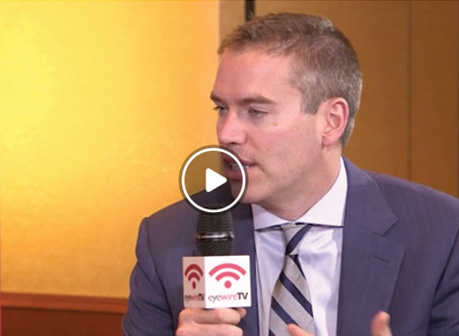
The tremendous success of cataract surgery has made it the most common surgical procedure in the United States, with more than 3 million patients undergoing surgery each year.1 Although consistently great outcomes have largely extinguished the fear associated with cataract surgery, surgeons must not become complacent. Rather, they must always ask themselves, “How can we make the experience even better for our patients?”
AT A GLANCE
• Many cataract patients are nervous about intravenous (IV) administration, particularly if they have “challenging” veins, and the process of starting the IV slows down staff and patient flow.
• The midazolam-ketamine-ondansetron or MKO Melt is a sublingual tablet that delivers the medication over a 2-minute release period. The effects of conscious sedation are evident after 2 to 3 minutes and peak at about 15 minutes.
• Available in a two-tablet peel pack, the MKO Melt active ingredient concentrations are 3 mg midazolam, 25 mg ketamine, and 2 mg ondansetron. This dosage level is effective for more than 95% of patients. The remaining 5% (typically very young or very anxious patients) may need IV supplementation. In these situations, the author’s team administers two melts and starts the IV after patients are somewhat sedated.
The postsurgical eye drop regimen is often the most difficult part of cataract surgery for patients. Innovative pharmaceutical formulations and delivery systems such as DropLess/LessDrops (Imprimis Pharmaceuticals), various gel suspension formulations, and drug delivery systems under development from a variety of companies are addressing this concern with great results. The second most significant aversion associated with cataract surgery is likely intravenous (IV) administration. Many patients are nervous about IVs, particularly if they have “challenging” veins, and the process of starting the IV slows down staff and patient flow.
Vance Thompson, MD; William Wiley, MD; Chris Bender, CRNA; and I set out to find an alternative to the traditional IV.
BACKGROUND
After some research, our initial solution was sublingual anesthesia delivery. Our patients, monitored by an anesthesiologist or certified registered nurse anesthetist (CRNA), received oral midazolam. The patients liked it, and we liked it. We found that, overall, this delivery method was an improvement over the traditional IV. We decided to add ketamine to induce a relaxing and analgesic effect, bt ketamine was not available sublingually, however, and we did not feel that this was enough to merit starting an IV (albeit a compelling reason). To resolve this problem, we challenged our anesthesia team to determine how to administer an aqueous solution of midazolam and ketamine sublingually. We used this formulation in more than 1,500 patients, and we were so confident of its efficacy that we no longer felt it was necessary to set up an IV unless we anticipated a long or complicated surgery or had a particularly anxious patient. This approach was successful, although it was difficult for patients to keep this amount of bitter-tasting liquid under their tongue. We then approached Imprimis, and conscious sedation midazolam-ketamine-ondansetron or MKO Melt was born.
THE MKO MELT
The MKO Melt is a slightly bitter sublingual tablet that delivers the medication over a 2- to 3-minute release period. As the tablet coating melts, the patient also “melts away” into a state of conscious sedation. The effects are evident after 2 to 3 minutes and peak at about 15 minutes. We have successfully performed a planned complex 57-minute surgery without needing an IV supplement.
The MKO Melt tablet offered us several advantages over the liquid-only administration and has improved our OR flow even more than when we began using liquid sedation instead of the IV. First, dispensing the medication is simply a matter of having the patient place the melt under the tongue until it fully dissolves. Second is the added benefit of a standardized level of sedation. Third, we find that patients ease into and out of the anesthesia more gently than with IV sedation.
Available in a two-tablet peel pack, the MKO Melt active ingredient concentrations are midazolam 3 mg, ketamine 25 mg, and ondansetron 2 mg. This dosage level is effective for more than 95% of patients in our experience. For the remaining 5% (typically very young or very anxious patients), we may need IV supplementation. In these situations, we administer two melts and start the IV after the patient is somewhat sedated. Usually, we do not use the IV, but it is available if necessary. Ultimately, it is up to the anesthesiologist to assess factors such as age, size, anxiety level, and case specifics to determine dosage of one or two melts and whether or not IV supplementation is necessary.
MAKING THE TRANSITION
We expect a period of trepidation any time we transition to or test new methods. Many anesthesiologists may be hesitant to go into a surgery without IV access; when starting off with the melt, I would suggest starting the IV with a hep-lock. As the surgeon and the anesthesia team become more familiar with the routine and gain firsthand experience with the MKO Melt, the team may no longer find it necessary to hep-lock. Should an adverse event occur, the patient is surrounded by anesthesia professionals who can quickly give an IV.
Using the MKO Melt does not eliminate the need for an anesthesiologist/CRNA or make him or her ineligible for billing. Any time a patient is monitored after receiving sedation, it is reimbursable; IV administration is not a criterion for reimbursement. Intraocular surgery is not without risk, and working with elderly cataract patients can pose a level of unpredictability. We appreciate having an anesthesiologist or CRNA present during the procedure to ensure the best level of care for the patient.
The MKO Melt is also cost-effective. The cost of the peel pack is equivalent to that of the IV equipment setup and the drugs (before factoring in the cost of staff to administer and prepare it). With the time saved on administering and monitoring the IV, a significant improvement in patient flow has allowed us to add surgeries to our typical day.
WE WIN, AND THE PATIENTS WIN
The MKO Melt improves upon a process that many surgeons perform without a thought. This is about more than just getting rid of the IV; it is about standardized dosage, comfortable patient sedation, and improved surgical flow. Word of mouth is a powerful marketing tool, and we have had patients seek us out specifically to avoid an IV. Although utilitarian in purpose, the MKO Melt simply makes cataract surgery better. We win, and more importantly, our patients win.
1. The Center for Disease Control, Medicare. Cataract Statistics. Statistic Brain. http://www.statisticbrain.com/cataract-statistics. Accessed March 27, 2016.
John Berdahl, MD
• private practice at Vance Thompson Vision in Sioux Falls, South Dakota
• john.berdahl@vancethompsonvision.com
• financial disclosure: consultant to Imprimis



